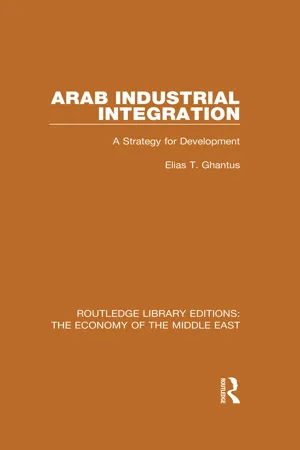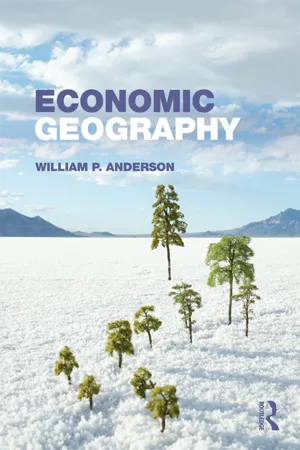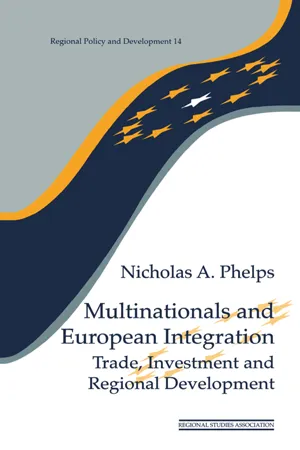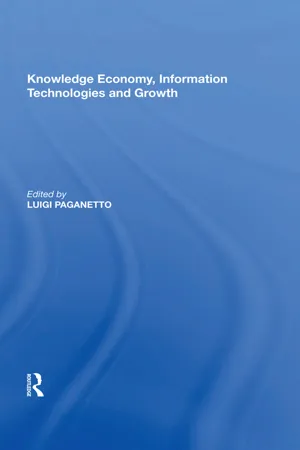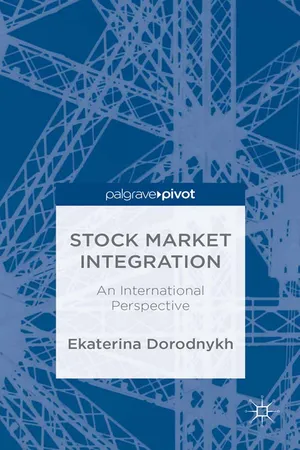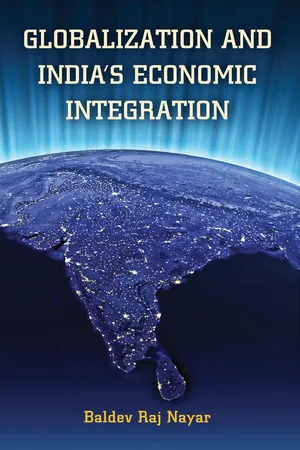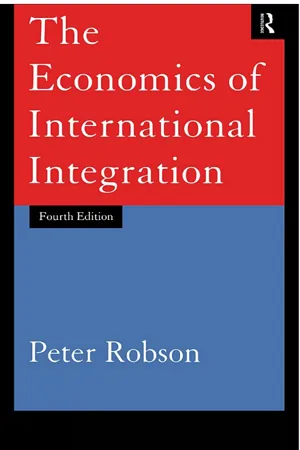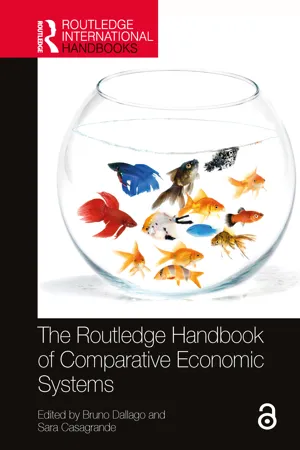Economics
Market Integration
Market integration refers to the process of combining separate markets into a single, unified market. This can involve the removal of trade barriers, harmonization of regulations, and increased coordination among market participants. The goal is to create a more efficient and interconnected market, leading to increased competition, lower prices, and greater economic opportunities for businesses and consumers.
Written by Perlego with AI-assistance
Related key terms
8 Key excerpts on "Market Integration"
- eBook - ePub
Arab Industrial Integration (RLE Economy of Middle East)
A Strategy for Development
- Elias T. Ghantus(Author)
- 2020(Publication Date)
- Routledge(Publisher)
It seems that the general approach to economic integration has been inspired by the theoretical writings on the formation of customs unions, within the broader field of international economic relations. This approach focuses on integrating the markets of the participating countries as a means for achieving an optimum reallocation of resources in the integrated area. In this context, several forms of economic integration can be perceived.The simplest form is the free trade area which involves the elimina- tion of tariffs and quantitative restrictions between member-countries, but each country is allowed to fix its own separate tariff rates on imports from non-member countries. A higher level of economic integration is the customs union, which involves, aside from the elimination of tariffs among member-countries, the unification of tariffs against the outside world. The common market is a still higher level of integration, adding to the customs union situation the removal of restrictions on the movement of factors of production among member-countries. The highest level of integration is the economic union which fuses national economies into a single unit (i.e. a trans-national economy), adding to the common market situation the harmonisation or unification of economic and social policies of member-countries, and this usually calls for the setting up of a supra-national decision-making body.As will be revealed later in this chapter, economic integration need not embrace all sectors of the economies concerned. Partial integration, limited to one sector or even one industry, has proved to be a more promising form of integration especially among developing countries. Such schemes are often referred to as partial customs unions with investment planning. It is useful to look at partial integration as a joint action to solve common development problems, in the sense that it focuses on production activities which cannot be carried out with relative efficiency by the individual countries concerned. This applies specifically to manufacturing industries whose minimum-efficient-scale - eBook - ePub
- William P. Anderson(Author)
- 2012(Publication Date)
- Routledge(Publisher)
1 Our objective here is more modest. Essentially, the next three chapters address the following question: how does the transition to a global knowledge economy affect the principles of economic geography as set forth in the first five sections of this book? Some observers argue that globalization and the proliferation of information and communications technology means that space is becoming irrelevant, distance is disappearing, so economic geography as we know it is out the window. But the fact that distance is getting easier to overcome does not mean it no longer matters. As we have already seen, reductions in the friction of distance lead to predictable changes such as increased scale of production and more spatial interaction. Perhaps most importantly, cheaper transportation and better communication make it easier for firms to exploit spatial differentiation at a global scale.These issues will be addressed in detail later, but at the outset some basic definitions are needed. The term “globalization” seems to have as many definitions as there are books and articles written about it. For the moment, let’s settle for a very simple definition of globalization as the integration of economic activity at a global scale. Of course, this begs the question: what do we mean by integration? International trade and foreign direct investment are both forms of economic integration that can be measured in terms of flows of goods or funds between nations. In these cases, production is still conducted within national borders. At a deeper level of integration, the production process itself involves tasks performed by different actors at different locations around the globe who are closely coordinated via information and communications networks. As we will see, people from a dozen or more countries may have been involved in the design, production, distribution and marketing of the shirt you are wearing right now. It is this more complex type of integration that most people have in mind when they speak of globalization. To make this distinction clear, we will use the term internationalization to refer to integration across national borders that involves goods that are produced in a single country but sold in to an international market. Internationalization is not distinct from globalization; rather, it is a limited form of globalization.The knowledge economy is not quite so easily defined. A precise definition, including an explanation of the distinction between information and knowledge, is deferred until chapter 26 - eBook - ePub
Multinationals and European Integration
Trade, Investment and Regional Development
- Nicholas A. Phelps(Author)
- 2013(Publication Date)
- Routledge(Publisher)
Such formalised progress towards economic integration naturally has considerable effects on the patterns and determinants of trade and investment not only within trade blocs themselves but also in the wider international economy. It is, therefore, worth situating EU integration in the wider context of the growing regionalism in trade and investment in the world economy.In a very general sense, economic integration has been occurring independent of any regionalisation in the world economy. As pre-capitalist and capitalist societies alike have created more and more complex divisions of labour so interdependencies between individuals, regions and nations have grown in the form of trade and investment. Economic integration on an international scale has a long history since capital in commodity form has long been internationalised through trade (Palloix, 1975, cited in Dicken, 1992). More complex forms of international economic integration are now evolving with the much more recent internationalisation of capital in the form of finance and direct investment. However, it would be wrong, as Hirst and Thompson (1992) point out, to assume that we live in a globally integrated economy since this requires truly global regulating institutions, truly transnational corporations operating on a globally-localised basis and a diminution of the influence of organised labour – none of which exist to any great extent in today’s world economy. Instead they characterise the world economy as ‘one in which the principal entities are nation states and [which] involves the process of growing interconnection between national economies’ (Hirst and Thompson, 1992: 358–359). Though even here such interdependencies are less than one might think (Krugman, 1996: 9). So that ‘The worldwide economy is one in which processes that are determined at the level of national economies still dominate and international phenomena are outcomes that emerge from the distinct and differential performance of the national economies’ (Hirst and Thompson, 1992: 310). Rather than truly global economic integration they recognise a growing economic integration on a regional scale – although even such regionalisation has rather shaky foundations. - Luigi Paganetto(Author)
- 2017(Publication Date)
- Routledge(Publisher)
1 . Intra-industry trade may also involve an exchange of vertically differentiated products, with the rich or capital abundant countries producing goods of higher quality. Income and endowment differences can thus form the basis for vertical intra-industry trade, which is an exchange of different varieties that are of different qualities.The effects of Market Integration on trade and specialization are therefore complex. In the traditional analysis of international trade, Market Integration should lead to a greater specialization of countries and regions according to their respective comparative advantages, leading to an increase in interindustry trade and a greater concentration of economic activities. Interindustry trade brings efficiency gains, with each country or region specializing in those sectors where it is relatively efficient, whilst consumers gain lower prices as a consequence. But this implies a deeper specialization between the less developed and the more advanced regions, each experiencing a contraction of some of its sectors and an expansion of others. For example, high-tech and capital-intensive industries should expand in the more developed regions and labour-intensive industries in the less developed regions. There are important adjustment costs and redistributive implications associated with this evolution.However, if we take into account imperfect competition, economies of scale and product differentiation, Market Integration could also lead to intra-industry trade. This last effect is likely to predominate in the European Union, as the factor endowments of the different member states (but not necessarily of the different regions) are converging (WIFO, 1999). This also implies that the industrial structures of these countries are likely to become more similar and that the concentration of specific industries in particular countries may weaken. Intra-industry trade benefits consumers by raising the variety of products on the market. Adjustment takes place amongst firms within industries and thus adjustments costs are lower. However, if intra-industry trade consists of an exchange of vertically differentiated products with the more developed member states specializing in higher quality products, the redistributive effects may nevertheless be significant.- eBook - ePub
Stock Market Integration
An International Perspective
- E. Dorodnykh(Author)
- 2015(Publication Date)
- Palgrave Pivot(Publisher)
1 tend to diversify their portfolios not only between national markets, but also between different types of business sectors. It implies the high level of financial integration, where the stock exchange integration has contributed significantly due to the fact that equity markets represent firms of the most important sectors in an economy of different countries. However, the process of equity Market Integration is gradual and takes many years, with occasional reversals. For instance, Carrieri et al. (2007) provide that stock exchange fusion is usually part of a major reform effort that includes the financial sector, the economy as well as the political process, where liberalization and deregulation in the money and capital markets of developed as well as developing countries push the equity markets to become more integrated.Thus, if the previous research studies provide the main features of the new regulatory and technological framework that make the integration between stock exchanges feasible mainly from a macroeconomic perspective, this study investigates the stock exchange behaviours in the integration processes, trying to figure out the main drivers that lead them to be part of a new (international) market institution. In this way, the consequences of integration processes among financial markets become especially important. The relevance of consequences related to the integration between stock exchanges for different stakeholders is confirmed by many scholars. For the financial institutions and investors, Market Integration allows economies of scale and scope and long-term gains from international diversification (Kim and Singal, 2000; Goetzmann et al., 2005; McAndrews and Stefanadis, 2002; Neumann et al., 2002; Carretta and Nicolini, 2006; Syllignakis and Kouretas, 2011). An integrated market supports the intermediaries and the issuers that benefit from higher efficiency and transparency, and they will avoid the duplication of costs related to the market infrastructure (Pagano and Padila, 2005; Varadi and Boppana, 2009). Furthermore, the investors benefit from more diversified portfolios, higher market liquidity and decreased volatility (Polato and Floreani, 2010; Dorodnykh and Youssef, 2012). In other words, the integration of the stock markets seems to be desirable for all its participants. - eBook - ePub
- Baldev Raj Nayar(Author)
- 2014(Publication Date)
- Georgetown University Press(Publisher)
We are not, however, without help in being enlightened on the issue. A study by Virmani and Mittal at ICRIER examined price variations of a large number of commodities in markets across India’s various regions in order to determine Market Integration. That study demonstrated greater integration in 2004 compared to 1994. In other words, the period after economic liberalization, which saw increased openness to the world economy, experienced higher domestic Market Integration rather than segmentation.The proposition that higher Market Integration rather than segmentation can accompany increased openness to the world economy is confirmed by the case of aviation, if we take aviation to be a proxy for trade. Unlike trade, there are separate data available for domestic air travel as against foreign air travel. What the data reveal is that increased international integration and the consequent expansion of foreign air passenger traffic have not led to any diminution of domestic air passenger traffic. Quite the contrary, both domestic and international air passenger traffic have seen continued and substantial expansion, with domestic air traffic staying ahead of foreign traffic. Increased domestic air traffic would denote greater domestic Market Integration. There does not seem to have been any zero-sum relationship in this case between international economic integration and domestic economic integration. Interestingly, while international air traffic increased faster than domestic air traffic in the initial phase of reform during economic liberalization in the 1990s, the subsequent phase of growth acceleration during liberalization saw a reversal of this trend and domestic air traffic expanded at a faster rate than foreign traffic. This pattern of comparative performance seems to confirm the proposition that growth acceleration has domestic integrative effects similar to autarky. - eBook - ePub
- Peter Robson(Author)
- 2002(Publication Date)
- Routledge(Publisher)
7 THE NEW ECONOMICS OF Market Integration
The orthodox theory of customs unions demonstrates that integration can provide expanded opportunities for countries to engage in inter-industry specialization within a bloc, in accordance with comparative advantage, thus bringing about a rationalization of its production. As long as the benefits from rationalization in the form of trade creation are not outweighed by reduced specialization brought about by trade diversion between the bloc and the rest of the world, as a result of the bloc’s discriminatory common external tariff, resource allocation will be improved. By that means a once-and-for all increase in the income and welfare of the member states as a whole may be brought about. The theory assumes a perfectly competitive framework in which homogeneous products are produced by firms that lack market power and incur few or no transaction costs. The core theory—customs union analysis—also excludes inter-country factor mobility.Although comparative advantage has always been a key concept in integration analysis, the thrust of much recent analytical and empirical work has been to question its relevance to contemporary trade and regional integration. The new emphasis has been prompted in part by the inability of the orthodox theory—even when scale economies are incorporated—to explain intra-industry trade in similar products. Yet a large part of modern world trade is made up of such trade. Indeed, much of the increase in intra-bloc trade in manufactures that took place following the establishment of the EC took that form and it has become a major component of trade in manufactures. New theories of trade have been developed which are capable of explaining this trade. As already noted, one explanation centred on the interaction of scale economies and product differentation (Krugman, 1979; Dixit and Norman, 1980). The other explanation turned on imperfect competition and the incentives it affords for engaging in active policies of market segmentation (Brander and Krugman, 1983). Both developments were responsible for a marked change in thinking about the gains from international trade and those from regional economic integration that became apparent from the middle of the 1980s. - Bruno Dallago, Sara Casagrande, Bruno Dallago, Sara Casagrande(Authors)
- 2022(Publication Date)
- Routledge(Publisher)
We take the view that all four components of the Single Market – free circulation of goods, services, capital and people – affect trade patterns, to a greater or lesser extent. As an obvious example, increased mobility of people and capital can alter the profile of comparative advantages, favour the attainment of scale economies, facilitate links with specific partner countries, etc. The chapter uses the OECD Trade in Value Added (“TiVA”) dataset 2 to investigate both sector-specific and country-specific features of trade integration, by disentangling the multiple interconnections among sectors and countries. The production of goods and services is not only directed to final demand; on the contrary, in an interconnected economy, with specialisation patterns driving trade and production, an increasing share of production is directed to intermediate goods and services, which serve as inputs for other sectors and countries. We consider those interconnections, both upstream (“backward linkages”) and downstream in value chains (“forward linkages”), to define the structure of the EU Single Market
Index pages curate the most relevant extracts from our library of academic textbooks. They’ve been created using an in-house natural language model (NLM), each adding context and meaning to key research topics.
